Mr. Ho, Paraguay 884, Centro. This is a sort of redux, a revisit, but not exactly. Those of you who’ve followed by various Korean adventures may remember, a couple of years ago, our visit to Mr. Ho in Floresta, which resulted in a flat “Ho No”. Now, I make no claims to having influenced this – but at least I added my voice to the online commentary that was, for much of its existence (about two years), leaning negative. The food wasn’t awful or anything, it was just a boring, somewhat bland, dumbed down version of “gastropub” Korean food for non-Koreans. So, when they announced that they were closing up shop, moving to the downtown area, and starting over from scratch with a completely new menu, of classic Korean dishes, I wasn’t sure whether to be, well, interested or not.
However, the first report from one of our Horde regulars was that it was really good. The place is split in two – there’s the “express” counter, upfront, which deals mostly with takeout, but there are also a few shared, high tables with barstools. The menu here is direct, simple, and to the point. For 300 pesos ($5), you get a bowl or takeout container of either white rice, vegetable fried rice, or vegetable sauteed noodles, and your choice of any one of a dozen “toppings” – classic Korean stir-fries for the most part. They don’t always have all twelve, but which one or two they’re missing does vary. For an additional 50 pesos, less than a dollar, you can get a second topping. And, if you’re really in a spendy mood, another 50 pesos will get you a bowl of kimchi that’s big enough for two to share.
And, then there’s the “salon”, where there are regular tables, maybe seating for about 40-50 people, and a full on menu with four appetizers, nine soups, and thirty different main courses, including a selection of vegetarian ones. Prices hover around 500 pesos, with most landing right on that, and a low of 400 and a high of 600, so all falling between $6-10. By the way, Mr. Ho exists – that’s him in the kitchen cooking, in the bright blue t-shirt. He also comes around and chats with customers regularly and turns out to be a really nice guy, and was appreciative of the note from us that this place is leaps and bounds better than the old one… “I listen to my customers”.
Three visits on my part have ensued….
On the first, I was solo, and I’m not clear why, but although I was eating in, they dished mine up in a to go container. Excellent noodles, a great black bean sauce (I do love my jajangmyeon), and a good, mildly spicy stir fried chicken (dakgalbi). The kimchi was excellent. Given that the express lunches also include a soft drink, lunch came to a whole, whopping, 400 pesos, or less than $7.
On a revisit with the Horde compatriot who’d touted it, we got our proper “eat-in” bowls, and he got the noodles with spicy calamari (ojingo bokkeum), and grilled short rib (bulgogi). All completely yummy.
I wanted to try the fried rice this time around, so got that (delicious), also the same calamari, and decided to try their tonkatsu, the breaded and fried pork cutlet, which was juicy, well seasoned, and properly sauced with tonkatsu sauce – not that gloopy tomato sauce or the honey-chili dressing that they offered us at the original place.
We liked the express enough that I thought it would make a fun outing for the rest of the Horde, and so a quintet of us grabbed a table one recent afternoon for outing #76. First off, ban chan included at the salon tables – two types of kimchi, a vegetable omelette, and a sort of odd little potato salad.
The group apparently wanted to disavow themselves of all responsibility, and thrust it into my hands. So I just picked a bunch of dishes that I like, and also that gave us some variety of style. We started with a dolsot bibimbop – the hot bowl of rice with meat, veggies and egg, and a bit of hot chili paste to mix in. Quite good!
I tell you, I like my black bean noodles, so I ordered that one. Interestingly, instead of the lovely stir-fried egg and wheat noodles that come with the express version, in the salon they’re served over gleaming white noodles, what appear to be somen. I like the ones on the express line more, but the dish is still delish. (And, this reminds me, I never moved on to explorations of the other noodles styles I talked about back with the somen ones.)
The spicy stir-fried pork belly in the jeyuk bokeeum was easily the best dish on the table. It had a great kick, it was packed with pork and vegetables, and it’s easily a portion for two people to share.
Likewise the tteok bokki, which I’ve never seen served this way. Usually you get those log or lozenge shaped rice cakes in a chili, onion, and garlic sauce – see here or here. Our waitress brought a little tabletop propane burner, and a huge pot (this is enough for 3-4 people) filled with broth, vegetables, eggs, rice noodles, wheat noodles, fish cakes, and more, and set it to start heating up. Once it got to the bubbling away stage, and we weren’t quite sure if we should step in, Mr. Ho arrived at the table and began to toss it all together, and cut things into pieces, and then add some condiments to it. While I do like the spicy version I’ve had elsewhere a lot, this was really good, and I’d happily eat it again.
I feel a little bit like I’m buying into a stereotype of not having liked the place when it “stepped outside its box” for Korean food and suddenly liking it “when it knows its place”, but it wasn’t that, it was just that when they stepped out, they didn’t do it all that well, unlike, say, Kyopo or Na Num.
So, Mr. Ho is no longer a Ho No, but a Ho Yes!
Cho Dae Gam, Felipe Vallese 3351, Floresta. It’s not always easy to find the hidden away spots, I mean, that’s kind of the point. But in this day and age of social media, things get found. Perusing the Floresta barrio coreano on Google maps, block by block, clicking on the various restaurant symbols, and things which are just labeled with Korean characters, has yielded up a few gems here and there. A couple of us headed out to see what we could find in situ. My companion arrived first at what was supposed to be the Sunshine restaurant on San Nicolás, gamely pushed the buzzer, but in response to inquiry was told, “no Korean food” – inside, I gather, looked like it was under renovation – so maybe a re-look in a month or two to see if it’s been replaced with something. I met him at location two, a block or so away on Lamarca, for what was supposed to be a jungwha yori (Korean-Chinese) place called Han, but the building was completely under construction. Knock those off the list.
Now, I’d been past this place before. Nothing on it indicates that it’s a restaurant, and although Google had a restaurant symbol there, they had no name, just the address (that’s now been fixed), nor what type of place it was. I’d laboriously translated the sign above the door and the one on the door – resulting only in “Cho Dae Gam” – which Google and other services say translates as “coarseness” [Side note: the young man, you’re about to hear tell of, told me the name “basically” means “Mr. Cho”, which must be a grammatical thing based on “dae ga”, which in one translation can mean “master”, so we’ll go with his version.], and the other was a set of instructions in Korean (I’d photographed it in passing a few weeks back and translated it at home) that tell you to reach inside the gate, press the buzzer, and wait, and to please not press it again, even if it took a couple of minutes, someone would come to the door. But no indication of what sort of place it was.
So, after waiting about 30 seconds, a young man arrived at the door. We inquired about whether it was a Korean restaurant, he said yes, but they only offer lamb soup, and it’s very spicy, and not for us. But we like lamb soup and we like spicy, and we’d love to try it. He seemed to consider it, but opined again that he thought we wouldn’t like it, and that maybe we would be better off going to another type of restaurant. We pressed. He relented, he said. But then closed the door in our faces… only to reopen it about ten seconds later, apparently having yelled to someone in the back to buzz the gate open – interesting that it has to be done from the back, they can’t open it from upfront.
Good sized place, and it was clear, they’re setup for Korean barbecue as well. But maybe not at lunch? He offered that well, yes, in addition to their lamb soup, they offer Korean barbecue. Now, the spicy lamb soup was already a given, after our push, we couldn’t very well say no to it. And, besides, we like lamb soup and spicy. So, what about the pricing? Quite moderate it seems – for one person, you can get either the soup or the barbecue, 700 pesos, about $11.50. For two people, you can get either the soup or the barbecue for 800 pesos, or about $13.50. We decided we could swing both, even though it was likely to be a lot of food.
The soup arrived first, a pot of broth filled with chopped lamb and lamb “parts”, and a huge pile of greens and herbs. A lid was placed atop, the fire was started, and it was left to bubble away for about 15 minutes.
We tasted the broth and it was quite mild, but he’d brought a couple of dishes of gochujang chili paste and shiso seeds, and we, I think to his shock, put both dishes full into the pot. Now it had a kick, still not overly spicy, but quite good. It was a very different style from the lamb soup that we love at Casa Bonga, this was very herbal – with a mix of cilantro, mint, shiso, and green onion flavoring pretty much every bite – I liked it a lot more than my companion did. We both were of mixed thoughts on the lamb “parts” – some of them were a bit chewy, and a few were unidentifiable, but, I’m more of an offal person than he is, and I’d happily eat this again.
The barbecue setup arrived, with a good selection of banchan, but most of it, even the couple of types of kimchis, was a bit bland. The only thing in the banchan that we really loved was the green onion salad – which bordered on being a sort of fresh-made kimchi of green onions, chili, sesame, and sugar. We ended up not just nibbling on it, but stuffing it into the lettuce wraps for the barbecue.
Two types of meat served – pork belly and some sort of beef steaks. Decent quality. And again, appreciated the selection of herbs, the same ones as in the soup, to add to the wraps. Minor negative, all the lettuce leaves were fairly small, no nice big ones for creating wraps, so we had to double them up, which turned out to be a bit messy.
And we did good – we finished most everything. But in the end, we were just a bit underwhelmed. On the other hand, if you’re two people, having the price only go up by 100 pesos, only a dollar and half, makes for the cheapest Korean barbecue in the city, since most places charge you the full per person price for each additional person. Also means that if you’re solo, you can come for the barbecue – most of the places refuse to serve it unless you’re at least two people.
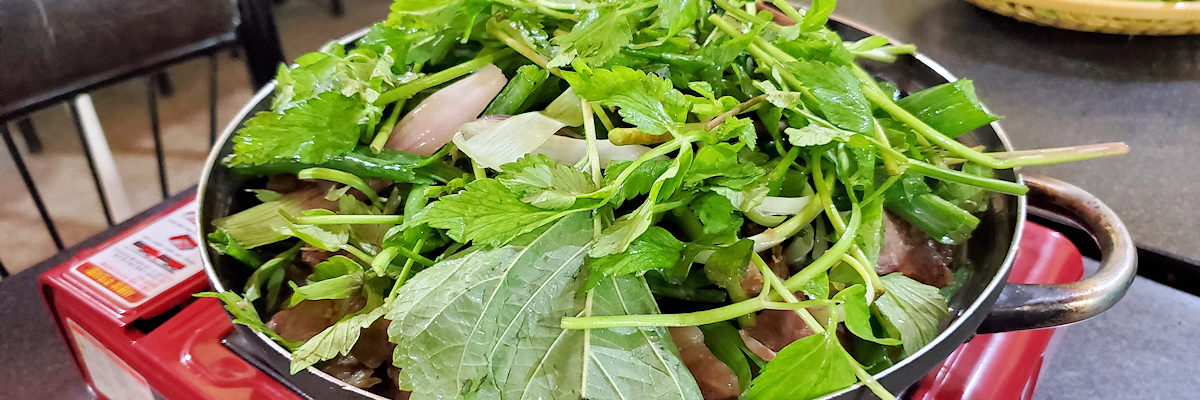
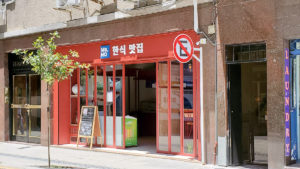
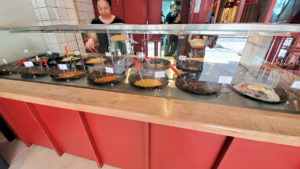
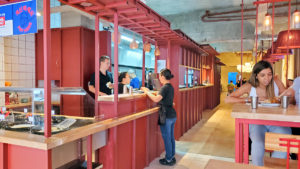
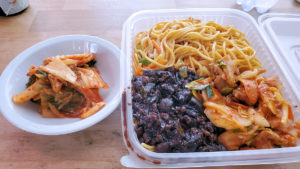
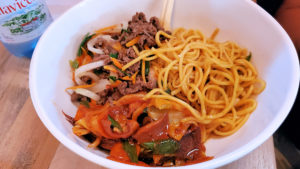
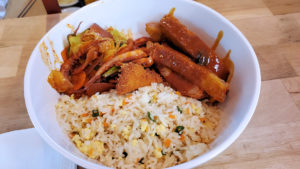
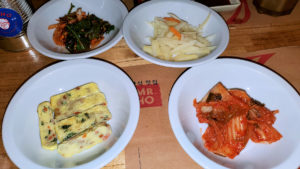
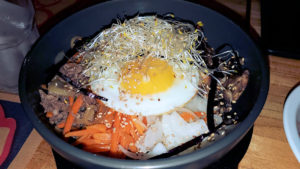
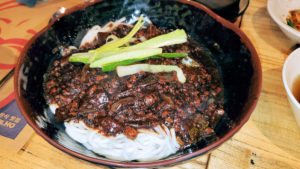
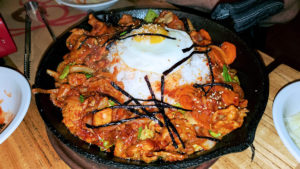
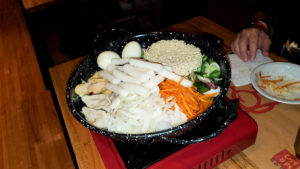
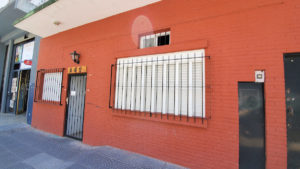
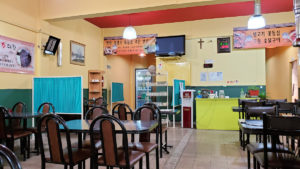
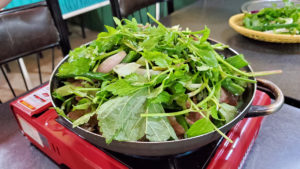
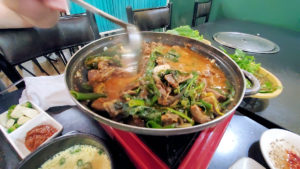
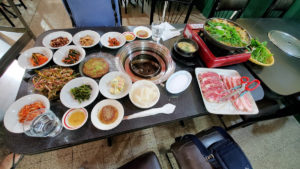
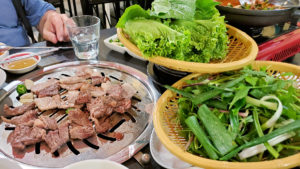
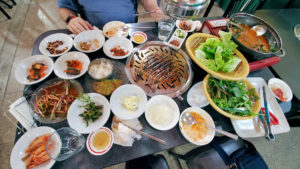
[…] several visits. So Steven, I, and a friend of his met up for lunch to check it out. [Closed up and moved to the downtown area, completely revamped with a new menu and […]
[…] off to one of our two Koreatowns, for the first time since pre-pandemic – actually since December 2019! We decided on the Floresta Koreatown, and met up at one of the two branches of Han Obaeknyeon, at […]